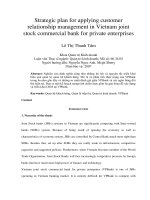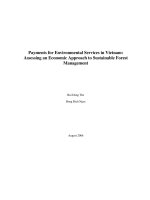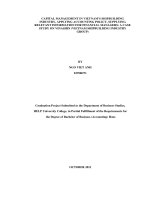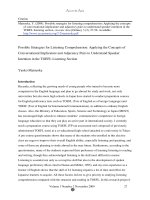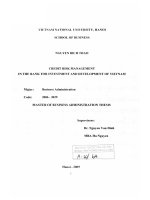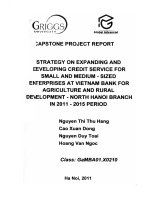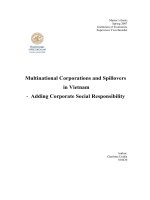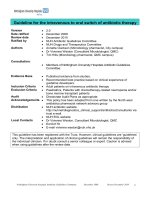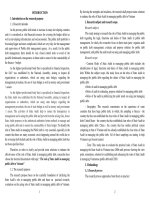POLICY CREDIT MANAGEMENT IN VIETNAM BANK FOR SOCIAL POLICIES TO MEET TARGETS OF POVERTY REDUCTION AND ENSURING SOCIAL SECURITY
Bạn đang xem bản rút gọn của tài liệu. Xem và tải ngay bản đầy đủ của tài liệu tại đây (247.45 KB, 28 trang )
MINISTRY OF EDUCATION &TRAINING
STATE BANK OF VIET NAM
ACADEMY OF BANKING
DUONG QUYET THANG
POLICY CREDIT MANAGEMENT IN VIETNAM BANK
FOR SOCIAL POLICIES TO MEET TARGETS OF
POVERTY REDUCTION AND ENSURING
SOCIAL SECURITY
DEPARTMENT: FINANCE – BANKING
CODE: 63.34.02.01
ABSTRACT OF PhD THESIS
HANOI - 2016
THE THESIS IS COMPLETED AT
ACADEMY OF BANKING
Instructor:
1. Assoc.Prof. Dr. Kieu Huu Thien
2. Dr. Nguyen Quang Thai
The thesis was defended before the Assessment Council for PhD
Thesis
of
Academy
level
at
........
hour,
..........................................2016 at Academy of Banking.
The Thesis can be found at:
- Library of Academy of Banking
- National Library
dated
1
INTRODUCTION
1. Rationale
Entering the third Millennium, humanity witnesses thriving
development of science and technology, but also faces an enormous
challenge: Poverty. After 12 years of construction and development, to
accompany the poor and other social policy beneficiaries, VBSP has
overcome many difficulties, affirmed its important role in poverty
reduction and social security as a reliable address to provide credit to
the poor and other social policy beneficiaries. Despite significant
achievements, poverty reduction is facing a huge limitation globally:
unsustainable poverty reduction. In Vietnam as well as all over the
world, relapse into poverty is happening and poor group is still being
added every year.
Facing the situation, the author chose the theme: "Policy credit
management at Vietnam Bank for Social Policies to meet targets of
poverty reduction and ensuring social security" as the subject of
this doctoral thesis.
2. Literature Review
Many studies in the world have discussed about microfinance
and policy credit. Authors representing research of this topic are:
Frede Moreno (2004) “Good governance in microcredit strategy for
poverty reduction: Focus on western Mindanao, Philippines”; Takyi,
Emmanuel Ankrah (2011) “Micro-credit management in rural Bank:
The case of Baduman rural Bank Ltd; Agba,A.M.ogaboh, Stephen
Ocheni and Festus Nkpoyen (2014) “Microfinance Credit Scheme
and Poverty Reduction among Low-Income Workers in Nigeria”;
Mario Olivares and Sofia Santos (2009) “Market Solutions in
Poverty: The Role of Microcredit in Development Countries with
2
Financial Restrictions”; Janda K. and P. Zetek (2014) "Survey of
Microfinance Controversies and Challenges" ; Wright, Graham
(2000) "Designing Quality Financial Services for the Poor”.
Domestically, research topics related to the policy credit has
been widely studied, but topics directly related to policy credit
management to meet targets of poverty reduction and ensuring social
security has still been in narrow range.
In summary, research topics have been in narrow scale or in
some certain aspects, not many research has focused on the full range
of contents related to policy credit management. Furthermore, as
objects of studies differ due to geographical and historical constraints
and with many socio-economic fluctuations so far, researches have
only solved a part of issues relating to microfinance. Such solutions
are not in uniformity to enhance the role of microfinance and policy
credit to meet targets of poverty reduction and ensuring social
security for Vietnam in current context.
3. Objectives
The ultimate goal of this research topic is to propose measures
to enhance policy credit management in order to better respond to
targets of poverty reduction and ensuring social security in the period
of 2015-2020 and beyond. To accomplish the goal, the authors focus
into the following:
- Clarification of policy credit basic theory and specific
contents of policy credit management. The system of credit
management process and criteria for evaluating the effectiveness of
policy credit management and system of factors that affect its
implementation. Experience and international practice in policy
credit management.
3
- Assessment of the status of policy credit management in
VBSP, outlining achievements, constraints and reasons.
- Propose solutions and proposals to strengthen policy credit
management in VBSP to meet targets of poverty reduction and
ensuring social security.
4. Object and research scope:
- Object: The research focuses on policy credit management
in Vietnam Bank for Social Policies.
- Research scope: The research focuses on the period since
Vietnam Bank for Social Policies’ establishment to the end of
2014 and in the whole network of Vietnam Bank for Social
Policies.
5. Methodology
The thesis uses the method of interpretation, analysis,
synthesis, statistics, comparison, empirical method and survey.
Specific research methods applied are: Field observations to
understand the status and impact of policy credit activities in VBSP;
Get expert opinions through direct interviews and through workshops
- symposiums; Analyze and synthesize data and forecasts.
6. New contribution of the research
Theory: The thesis has codified and systematically analyzed
forms of policy credit and contents, methods of policy credit
management.
In practice: SPSS software is used to input data, analyze
survey results, and quantify the influences of some factors to the
implementation of policy credit management in Vietnam. At the
same time, one-way ANOVA is used test to confirm the assessment
collected from surveyed households to be statistical significance.
4
Recommendations:
enhance
policy
credit
The Thesis has proposed measures to
management
in
VBSP,
and
made
recommendations to the Government, the Ministries, and the State
Bank, local authorities, the Fatherland Front and mass organizations
to create an environment as well as legal basis and to enhance
capacity of VBSP in policy credit management.
7. Structure
Besides the introduction and conclusion, the Thesis includes
three chapters as follows:
Chapter 1: Theoretical bases of policy credit management.
Chapter 2: Current status of policy credit management in
Vietnam Bank for Social Policies.
Chapter 3: Solutions to policy credit management in VBSP
to meet targets of poverty reduction and ensuring social security.
5
CHAPTER 1
THEOREOTICAL BASES OF POLICY CREDIT
MANAGEMENT.
1.1. POLICY CREDIT
1.1.1. Concept of policy credit
Policy credit means providing poor people with small loans to help
them engage in productive activities or grow a small business.
According to European Commission (2000), microfinance
concepts are understood in a broader sense: the provision of a wide
range of financial services including savings, loans, payment
services, money transfers and insurance to poor people, low-income
households and small businesses.
According to Article 1, Decree 78/2002/ND-CP dated
04/10/2002 of the Government, social policy credit is defined as
follows: " Credit for the poor and other policy beneficiaries means
the use of State-mobilized financial sources to provide preferential
loans for poor people and other policy beneficiaries in service of
production, business, job creation and life improvement, thereby
contributing to the implementation of the national target program on
hunger elimination and poverty alleviation, and social security”.
1.1.2. Features of policy credit
Firstly, a credit institution designated by the State or established
by the State to implement policy credit in the field of social security.
Secondly, the credit policy is the government's credit channel,
operates not for profit purposes.
Thirdly, policy credit borrowers are the poor and other policy
beneficiaries designated by the Government.
Fourthly, funds for policy credit is from the State budget, ie.
6
Funds from the State budget and derived from the State budget.
Fifthly, the Government or the person authorized by the
Government shall make decision on interest rates, loan terms, loan
procedures and approach to policy credit funds.
Sixthly, diverse lending methods
1.1.3. Types of policy credit
- Based on the loan duration: 03 types, including short-term,
medium - term and long - term credit.
- Based on the assurance to repay: 02 types, including
unsecured credit and secured credit.
- Based on operation: lending to industries of national strategic
importance; projects which is financially feasible, but require too
much investment or too long repayment period; and lending to aim at
reducing poverty and ensuring social security
1.1.4. Policy credit risks
Policy credit risks are recognized under 2 angles: objective
risks and subjective risks. Objective risks are due to objective reasons
such as disasters, war, the borrower dies or missing and have no heirs
or due to other unexpected incidents causing loan loss while the
borrower has strictly follow policy regime. Subjective risks are from
both sides, the policy credit institution and the borrower.
1.1.5. Roles of policy credit
- Policy credit is a solution to reduce poverty and ensure social
security in Vietnam.
- Secondly, policy credit contributes to economic development.
- Thirdly, policy credit contributes to the country's political
stability.
7
- Fourthly, policy credit is to bridge and facilitate functions
and tasks of mass organizations.
- Fifthly, policy credit contributes to strengthen the
management role of local government.
- Sixthly, policy credit contributes to narrow the gap of socio economic development between regions in the country.
1.2. POLICY CREDIT MANAGEMENT
1.2.1. Definition of policy credit management
"Policy credit management is a process consisting of uniformly
coordinated and linked activities from the central to grassroots levels
of government, mass organizations, VBSP and borrowers in the
policy credit sector aiming to reduce poverty, ensure social security
at the lowest cost and highest efficiency".
1.2.2. Policy credit management
Policy credit management must comply with basic contents,
certain and tight processes. The first content of policy credit
management is policy credit funding management; secondly, policy
credit management is to manage borrowers; thirdly, the loan
conditions; fourthly, the credit limit or the loan; fifthly, the network
administrator; sixthly, loan term and repayment period; seventhly,
loan classification and risk provision. Eighthly, loans security.
1.2.3. Policy credit management methods
From research review, some policy credit management
methods can be listed as following: economic method; administrative
method; education method; and analysis and statistical method.
1.2.4. Criteria to assess the effectiveness of credit policy
Social efficiency: Demonstrating in economic, political and
8
social effectiveness. The supreme goal of policy credit is hunger
eradication, poverty reduction, socio - political stability and ensuring
social security. Policy credit is one of the solutions to thoroughly
implement the National target program on hunger eradication and
poverty reduction.
Economic efficiency: to consider from the perspective of cost
savings for the State budget, mitigate damage leading to loss of
capital, efficient use of funds from the state budget and mobilized
funds for social security etc,.
1.2.5. Factors affecting policy credit management.
- The socio - economic environment;
- Financial capacity and risk management system;
- The quality of staff and network organizational structure;
- Information technology.
1.3. INTERNATIONAL EXPERIENCE OF POLICY CREDIT
MANAGEMENT
Through the experiences of policy credit management in some
countries in the world such as Bangladesh, India, Indonesia,
Thailand, Japan, Euro zone and North America, some countries in
South America and Africa to draw some lessons about policy credit
management in Vietnam.
Firstly: Diversification of resources for poverty reduction targets.
Secondly: Harmonious combination between the resources of
the public sector and private sector in poverty reduction credit
activities.
Thirdly: Develop forms of poverty reduction support through
microfinance institutions
9
Forthly: To continue development, VBSP should apply
effectively operation forms of a microfinance institution.
10
CHAPTER 2
POLICY CREDIT MANAGEMENT IN VIETNAM BANK FOR
SOCIAL POLICIES
2.1. OVERVIEW ON VIETNAM BANK FOR SOCIAL
POLICIES
2.1.1. History and operation characteristics
VBSP is a legal entity with the charter capital, its own seal,
legal assets and nationwide transaction network from central to local
level, a nation-wide unified management and administration
apparatus and its Headquarters based in Hanoi. VBSP acts as a nonprofit credit institution that is currently in charge of providing policy
credit to the poor and other policy beneficiaries. The initial charter
capital is VND 5,000 billion, which is supplemented in
corresponding to operation requirements periodically. Its operation
duration is 99 years. The operation structure is under a systematic
and unified management.
2.1.2. Achievements
2.1.2.1. Banking funding sources
VBSP funding sources consist of: (i) Funding from the
Central State Budget; (ii) Borrowings and mobilized fund; (iii)
Entrusted capitals. The development of VBSP banking funding
sources reported over the last years is remarkably enhanced, not only
in growth and quality but also in structure. The total funding source
was VND 9,047 billion at the time handed over from the Bank for the
Poor. As of 31 December 2015, the total capital reached VND
146,460 billion, making an increase of VND 135,936 billion in
comparison with the number in 2003.
11
2.1.2.2. Banking portfolio
During early days of operation, VBSP only implemented three
policy credit programs. The bank currently implements 20 policy
credit programs assigned by the Government. As of 31st December
2015, 07 biggest credit programs in the outstanding loans accounted
for 95% of the total, namely: poor households program at 25.5%;
near-poor households program at 19.3%; disadvantaged students
program at 17.2%; rural water supply and sanitation program at
14.1%; production and business in disadvantaged areas program at
10.9%; job creation program at 4.8% and housing for the poor
program at 2.6%. Additionally there are policy credit programs for
migrant workers abroad for limited term, migrant workers abroad
living in poor districts, housing purpose with deferred payment in
Mekong river delta, extremely disadvantaged ethnic minority
households, housing for the poor against flood in North Central and
Central Coast etc,. VBSP policy credit programs are all implemented
for
poverty
reduction,
social
security
and
socio-economic
development. All the policy credit programs which diversify VBSP
credit operation and make contribution to channel policy credit to the
people are highly recognized by the people, the Party, the State and
the policy credit management capacity of VBSP is recorded.
2.1.2.3. Communication and international cooperation
The role and position of VBSP in international relations are
improved noticeably through the communication and international
cooperation over the last years. In the Microcredit Summit Campaign
Report, VBSP stands the second in the scale of program for rural
water supply and sanitation, the third in the number of active
12
borrowers among 10,000 microfinance institutions and banks around
the world. VBSP continuously develops and enhances cooperation
with international organizations at home and abroad to implement
various projects.
2.2. POLICY CREDIT MANAGEMENT IN VIETNAM BANK
FOR SOCIAL POLICIES
2.2.1. Policy credit management in Vietnam Bank for Social
Policies
2.2.1.1.
Management
of
funding
sources
for
policy
credit
implementation
VBSP funding sources consist of 05 sources: (i) Funding
from the Central State Budget; (ii) Borrowings designated by the
Government ; (iii) Fund mobilized and borrowed with market interest
rate; (iv) Entrusted capitals from the local state budget, economic
organizations and individuals; and (v) Other funds and capitals.
- Based upon the mobilization interest rate, there are two
sources as follows: non-interest bearing funding and low-interest
bearing funding.
- Based upon the mobilization term, there are two sources as
follows: short-term funding and medium and long-term funding.
During early period of operation (2002-2006), the funding
mobilized at the market interest rate accounted for higher proportion
than the non-interest bearing and low-interest bearing funding. From
2007 up to now, the non-interest bearing and low-interest bearing
funding conversely has accounted for higher proportion. When VBSP
is on the way to stability and development, VBSP puts priorities to
mobilize non-interest bearing and low-interest bearing sources to
minimize the subsidies from State Budget as legislated.
13
For the period 2003- 2010, VBSP focused on long-term
funding, which was the largest proportion of the total capital (accounting
for 87.67%) in 2010. From 2011 up to now, this proportion has been
reducing insignificantly, still accounting for over 70%. The medium and
long-term funding is absolutely appropriate with VBSP medium and
long-term lending to its borrowers, facilitate VBSP implement
effectively policy lending and ensure the solvency.
2.2.1.2. Lending management
VBSP
has
tightly
collaborated
with
socio-political
organizations to successfully reach the goals assigned by the
Government in focusing strong sources to make breakthroughs in
poverty alleviation and social security; strengthen the quality and
effectiveness of policy credit; separate policy credit from commercial
credit; mobilize all forces of the society in poverty reduction and
alleviation of money-lenders in rural areas.
As of 31st December 2015, total outstanding loans reached
VND 142,528 billion, representing 18 times increase compared with
the number of early operation in 2002. There are over 6,863 active
borrowers with the average outstanding loans of VND 20 million
each. VBSP currently implements 20 policy credit programs with
27.9 million turns of borrowers so far. As of 31st December 2015,
the total overdue debt and frozen debt was VND 1,107 billion,
representing 0.78% of the total (including VND 468 billion of
overdue debt, VND 639 billion of frozen debt).
2.2.2. Methodology of policy credit management by Vietnam Bank
for Social Policies
Firstly, VBSP policy credit implementation is under the
management and supervision of many relevant agencies.
14
Secondly, VBSP policy credit implementation is under the
systematic and unified management in the whole system.
Thirdly, VBSP performs the policy credit management under
the mechanism of assigning planned credit targets.
Fourthly, VBSP performs the policy credit management under
the supervision and monitoring.
2.2.3. Effectiveness of policy credit management by Vietnam Bank
for Social Policies
2.2.3.1. Social impacts
- The target on the average rate of poor households having
demand for policy credit and can access VBSP’s loans over the past
five years (2010-2015) is 87%. The rate reportedly is most likely to
stably increase over the years.
- The rate of disadvantaged students in need of policy credit
accessing VBSP lending is always over 90% and makes a breaking
growth of almost 100% over the last two years.
In addition, the rate of migrants workers abroad in need of
policy credit accessing VBSP lending is very high (90% in 2010 and
nearly 100% in 2015). Noticeably the rate of post-rehabilitation
persons having stable job and successful rehabited is over 80% and
even nearly 90% by the end of 2015.
2.2.3.2. Economic impacts
The non-performing loan rate of VBSP is reportedly always
below 1.4% over the last five years. Accordingly the risk of funding
loss is under good control and the secured and stable operation of
VBSP is enabled, in contribution to cut down the operation cost such
as cost for loans management and non-performing loan handling etc,.
The rate also reveals that VBSP provides policy lending to eligible
15
target groups, who invest borrowed money effectively and efficiently
etc,.
2.2.3.3. Field survey
1,433 households surveyed highly appreciate VBSP policy
credit in production and business and life improvement. Policy credit
support in economic development, income improvement is the most
highly appreciated (by 67.8% surveyed households). Besides policy
credit support for housing is reportedly still insignificant (by 13.3%
of surveyed households).
The One-Way ANOVA presents the result of P<= 0,05, the
variance of different groups with different loan terms, there are
differences in the average value between the loan term of households
of the statistics and the policy credit impact on economic
development and income increase; improvement of living standards
and access to rural water supply and sanitation (P<=0.05). There is
also the difference in the average value between different groups at
different ages, particularly the policy credit impact on economic
development, income increase; improvement of living standards and
education level. Especially there are the difference in the variance
and average value among different households with different loan
sizes, the policy credit impact on almost activities of the households,
representing 7/8 activities (P<=0.05). There is no difference between
different loan amounts and different impact on education
improvement. Almost are satisfied with VBSP policy credit
mechanism, which is flexible and active on the aspects of target
groups.
2.3. EVALUATION OF POLICY CREDIT MANAGEMENT AT
VIETNAM BANK FOR SOCIAL POLICIES
2.3.1. Achievements
16
Firstly, concentrate financial sources to fund the policy credit,
basically satisfy the demand of policy credit for the poor and other
policy beneficiaries.
Secondly, the policy credit implementation has the socioeconomic impact.
Thirdly, the policy credit quality is continuously improved.
Fourthly, constitute the specific governance structure in good
correspondence with practical situation of the country.
Fifthly, establish and successfully implement the specific and
creative methodology of policy credit management in Vietnam.
Sixthly, establish and strengthen the tight, effective and
efficient management and administration apparatus and ensure
relatively sufficient material conditions to implement policy credit
programs.
2.3.2. Limitation and causes
2.3.2.1. Limitation
Firstly, the funding source for policy credit is still limited to
satisfy the demand of target groups.
Secondly, the limitations of operation mechanism, including
mechanism to establish and utilize the funding sources and financial
mechanism.
Thirdly, some localities still pay limited concern in supervision
and certification of poor households, near-poor households and other
policy beneficiaries in the area.
Fourthly, the collaboration between VBSP policy credit and
technical support, technology transfer of State organizations and
agencies, enterprises and socio-political organizations is still
limited.
17
Fifthly, the Representative Units of Board of Directors in some
areas still not in regular and comprehensive participation; limited
role, responsibilities and collaboration of some People’s Committee
at commune.
Sixthly, as in some provinces and cities with industrial
development there are no poor households under the national poverty
line, some provinces apply its own poverty line. There are still not
adequate funding source for lending to these target groups.
2.3.2.2. Reasons of constraints
Firstly, the State resources are limited, while various tasks
must be simultaneously implement for the aim of socio - economic
development.
Secondly, some local authorities have not identified poverty
alleviation as a priority task at present.
Thirdly, lack of centralized and unified direction and steering
mechanism from various authority levels.
Fourthly, lack of unified and effective linkage mechanism to
mainstream and coordinate between programs, socio - economic
projects in a same geographical areas, between policy credit activities
with activities of industrial promotion, agriculture, forestry, fishery
extension and technology transfer.
Fifthly, lack of separation between criteria to classify poor,
near - poor households being in shortage of working capital and
criteria to classify poor, near - poor households to be supported with
preferential policies on health care, education, social protection,
which affect the investigation and certification of poor, near - poor
households and other policy beneficiaries for providing loans.
18
Sixthly, organizational structure in some big cities is not in
conformity with reality, the method of arranging administration
apparatus according to geographical areas is inconsistent with the
changing trends of policy beneficiaries.
CHAPTER 3
SOLUTIONS OF POLICY CREDIT MANAGEMENT IN
VIETNAM BANK FOR SOCIAL POLICIES TO MEET
TARGETS OF POVERTY REDUCTION AND ENSURING
SOCIAL SECURITY
3.1. TARGETS OF POVERTY REDUCTION AND SOCIAL
SECURITY BY 2020
3.1.1. Target of poverty reduction and social security by 2020
The overall objective of the Government’s Resolution is
"Sustainable poverty reduction is a focal point of the Vietnam’s
Socio-economic Development Strategy in the period of 2011 - 2020
with a view to improving gradually the living condition of the poor,
especially in ethnic minority and mountainous areas; creating
comprehensive and powerful transformation in poor areas; narrowing
the gap between urban and rural areas, among regions, ethnic
minorities and resident groups ".
The 12th National Congress of the Communist Party of
Vietnam defines the task "Must concentrate on the close connection
between the economic growth with the realization of social justice
and progress; ensure social security, take care of physical and
spiritual life for all people, especially the poor and ethnic minorities
in extremely disadvantaged and remote areas... ".
19
Resolution No. 15/NQ-TW dated 1st June 2012 on some social
policies in the period of 2012-2020 also requires "The social policy
must be positioned on a par with the economic policy and
implemented comprehensively with economic development, in line
with the qualification of development and capacity of resources in
each period ... ", with a view to ensuring the minimum living
standard and timely support for disadvantaged people.
3.1.2. Policy credit demand in response to the national target of
poverty reduction and social security by 2020
To respond with the borrowing needs of poor households and
other policy based beneficiaries, there is a necessity to allocate a
funding source of around VND 200,000 billion by 2030, increasing
more than two folds compared to 2010. Each year increases around
more than VND 5,000 billion.
3.2. POLICY CREDIT MANAGEMENT TENDENCY TO MEET
TARGETS OF POVERTY REDUCTION AND ENSURING
SOCIAL SECURITY
Overall objectives
To develop the Vietnam Bank for Social Policies towards
stability and sustainability, enough capacity to better implement the
state policy credit associated with developing products and services
more effectively for poor households, near-poor households and
other policy-based beneficiaries.
Specific objectives
a) 100% of poor households and other policy-based
beneficiaries who have borrowing needs and eligible conditions are
entitled to access to products and services provided by VBSP;
b) The annual average growth of outstanding loans is about
10%;
20
c) The delinquency rate is below 3% in total outstanding loans;
d) Simplification
procedures;
and
standardization
of
professional
e) Diversification of products and services;
f) Modernization of expertise operation, integration with global
and regional banking systems;
g) To improve and promote effective and efficient operation of
controlling and monitoring systems, analyzing and warning risk;.
h) To coordinate and integrate policy credit activities
effectively with technical assistance, technology and science
transferring, industrial extension, agricultural, forestry and fishery
extension and activities of mass organizations with a view to rapid
and sustainable poverty reduction and social security.
3.3. SOLUTIONS OF POLICY CREDIT MANAGEMENT IN
VIETNAM BANK FOR SOCIAL POLICIES
3.3.1. Policy credit planning
To ensure that VBSP can implement policy credit programs
effectively and efficiently, there should be an orientation of policies and
mechanisms in terms of capital sources, interest rates, risk handling and
financial management.
3.3.2. Legal framework finalization for policy credit operation
To finalize the legal framework for VBSP’s operation is based
on collaboration with functional ministries and agencies to consider
and submit to the Government for amendment and supplementation
of some regulation contents of law in terms of policy credit for poor
households and other policy based beneficiaries; completing the
mechanism of creating capital source, financial management etc.,
with a regard to ensuring VBSP’s sustainable operation.
21
3.3.3. Solution of policy credit expansion
- There is necessity to formulate policy credit programs in
accordance with poor groups due to various reasons based on the
"multi-dimensional'' poverty approach.
- To expand other policy based beneficiaries such as people
meet with financial difficulty unexpectedly etc.
- Currently, there is a decrease in the poverty rate according to
the national standard in big cities and provinces with industry growth.
To expand the VBSP’s operation, on one hand, localities have to issue
the poverty standard higher than the national poverty standard. On the
other hand, there is need to allocate and transfer local budget for VBSP
to create the credit source. At the same time, it is essential to conduct
the subsidy mechanism for VBSP in compliance with the
government’s regulation.
3.3.4. Solution of finalizing the organizational structure and
human resources
- There is necessity to improvement in the structure of
governance; the management model towards the meditation level, to
strengthen management at central level, human source, the
organizational model of internal control system and restructure district
transaction offices as well as the function and task of the bank’s units.
- To focus on training and improving capacity of human
resource; to standardize professional officers in line with the
government regulation and the VBSP’s operation characteristic.
3.3.5. Solution of finalizing the VBSP’s operation mechanism
To finalize the mechanism of creating capital source, using
capital source and the financial regime of VBSP for the purpose of
sustainable development.
22
3.3.6. Solution of delinquency management
To carry on better management of risky debts due to objective
reasons in line with the prevailing regulation. To regularly require
branches to conduct frozen debt management, analysis and recovery
of frozen loans on time in order to apply measures in line with each
certain case and avoid the delay and dependence in work.
3.3.7. Solution of information technology improvement
- To finalize the core-banking system to help daily updating
transaction information exactly in the whole system.
- To finalize the core-banking based transaction process at
commune level, the information infrastructure to move towards
online transaction at commune transaction points with a view to
mitigating manual work and mediation, contributing to improving the
transaction ratio and labor productivity.
- To apply the modern technology system which enables to
support the existing expertise activities, provide new services and
products in future; to continue maintenance and technical support for
branches and units in the whole VBSP’s system.
3.3.8. Solution of innovation and improvement in
communication effectiveness
To strengthen communication on the preferential credit policy
of the government to all levels, agencies and residents. To develop
international cooperation for exchange of experiences and
information with international organizations over the world,
especially countries in the region, on micro credit for the poor and
policy beneficiaries. Seek for ODA sources and technical assistance
from international organizations to increase funding for lending,
training and strengthening of governance capacity of VBSP officers,
officers of entrusted mass organizations as well as management board
of savings and credit groups.
23
3.4.
RECOMMENDATIONS
ON
IMPLEMENTING
SOLUTIONS OF POLICY CREDIT MANAGEMENT IN
VIETNAM BANK FOR SOCIAL POLICIES
3.4.1. Recommendations to the National Assembly and the
Government
- The National Assembly should research and formulate the
Law on social policy credit to complete the legal framework for the
VBSP’s operation based on the amendment and supplementation of
the legal regulation contents on preferential credit for poor
households and other policy based beneficiaries.
- The Government should direct ministries and agencies to
respond increasingly with the borrowing demand of poor households
and other policy based beneficiaries; mandate one agency (such as
the National Steering Committee of Poverty Reduction) to act as a
main coordinator to help the Government harmonize and collaborate
in terms of poverty reduction programs and projects to overcome
overlapping and decentralization of the State resources; review
national target programs and transfer credit components for VBSP to
supplement the loan source.
3.4.2. Recommendations to Ministries and Agencies
- To support and create a convenient condition for VBSP to
access long term and cheap loan source.
- To research, review and finalize the preferential credit policy
for poor households and other policy based beneficiaries. To finalize
guidance documents for People’s Committees at all levels in order to
research, review and supplement timely the list of poor households,
near-poor households and other policy beneficiaries in order to
facilitate implementation of policy credit programs. To host and
review policies on poverty reduction and social security which are
